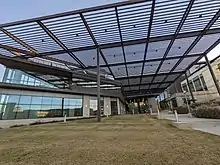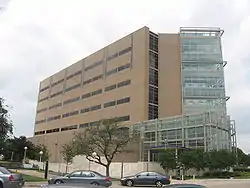Texas A&M University College of Engineering
The College of Engineering, formerly the Dwight Look College of Engineering, is the engineering school of Texas A&M University in College Station and is home to over 22,000 students in 15 departments.
Former name | Dwight Look College of Engineering |
|---|---|
| Type | Public |
| Established | 1880 |
Parent institution | Texas A&M University |
| Dean | John E. Hurtado (Interim) |
| Students | 22,863 (Fall 2022)[1] |
| Undergraduates | 12,942 (Fall 2015) |
| Postgraduates | 3,976 (Fall 2015) |
| Website | https://engineering.tamu.edu/index.html |
According to a 2009 report by the American Society for Engineering Education, the college is 2nd in the nation in undergraduate enrollment, and 6th in graduate enrollment. The same report ranks the College 8th in engineering degrees granted, 8th for the number of Hispanics and 10th for the number of women granted degrees. The college is 11th nationally for the number of doctoral degrees granted and 12th for master's degrees granted.[2] The college is recognized among the top public engineering colleges for its undergraduate and graduate programs.
Prior to 2016, the college was known as the Dwight Look College of Engineering.[3] The college was named after the civil engineering graduate, Harold Dwight Look, an army veteran of World War II who later founded a construction company on the U.S. Territory of Guam, where he lived for 40 years until his death on September 5, 2002, at the age of 80.[4]
In 1992, Look donated 1,146 acres in Guam valued at $52 million to the university.[5] It was the largest single gift ever received by the university, which later named the engineering college after Look. It was reported that Texas A&M was looking to sell the property in 2009.[4]
History

The first engineering department at Texas A&M appeared in 1880, four years after the foundation of the school, with the creation of the Department of Engineering, Mechanics, and Drawing. For the next several years, the curriculum focused on practical training to assist students in finding industrial and vocational work. By 1887, separate departments had been created for mechanical engineering and for civil engineering and drawing.[6]
To assist the United States during World War I, the Department of Mechanical Engineering shifted focus to train blacksmiths, automobile mechanics, machinists, draftsmen, general mechanics, and pipe fitters for the war. Following the war, the department's enrollment continued to increase, and it began offering courses in power, industrial and railway, or transportation engineering. In the 1930s, these options were eliminated, while others, including aerodynamics, air-conditioning and physical metallurgy began to be offered. During the 1936–1937 school year, the Department of Mechanical Engineering was first accredited by the Engineering Council for Professional Development, now known as the Accreditation Board for Engineering and Technology.[6]
By 1940, the engineering school comprised almost half of Texas A&M's enrollment. As World War II dawned, the school again assisted the war effort, with the Department of Mechanical Engineering faculty volunteering to teach at military bases throughout the state. Following the war, college introduced a Ph.D. program, and industries and government began to sponsor research within the college.[6]
Academics
Degrees offered[7]

- Aerospace Engineering - BS, MS, MEng, PhD
- Architectural Engineering - BS
- Biological and Agricultural Engineering – BS, MS, MEng, MAgr, PhD, EngD
- Biomedical Engineering - BS, MS, MEng, PhD
- Chemical Engineering - BS, MS, MEng, PhD
- Civil Engineering - BS, MS, MEng, PhD
- Computer Engineering - BS, MS, MEng, PhD
- Computer Science - BS, MS, MCS, PhD
- Computing - BA
- Electrical Engineering - BS, MS, MEng, PhD
- Electronic Systems Engineering Technology - BS
- Engineering - ME, DE
- Engineering Systems Management - MS
- Engineering Technical Management - MBA
- Engineering Technology - MS
- Environmental Engineering - BS
- Health Physics - MS
- Industrial Distribution - BS, MID
- Industrial Engineering - BS, MS, ME, PhD
- Interdisciplinary Engineering - PhD
- Manufacturing and Mechanical Engineering Technology - BS
- Marine Engineering Technology - BS
- Materials Science and Engineering - MS, ME, PhD
- Mechanical Engineering - BS, MS, ME, PhD
- Multidisciplinary Engineering Technology - BS
- Nuclear Engineering - BS, MS, ME, PhD
- Ocean Engineering - BS, MS, ME, PhD
- Petroleum Engineering - BS, MS, ME, PhD
- Radiological Health Engineering - BS
- Safety Engineering - MS
Rankings
The 2019 edition of the U.S. News & World Report ranks the Texas A&M University College of Engineering graduate program 15th and the undergraduate program 14th.[8]
Individual engineering programs as ranked among public institutions by U.S. News & World Report:[9]
- Aerospace: 10th graduate (2019), 9th undergraduate (2019)
- Biological and Agricultural: 3rd graduate(2019), 2nd undergraduate (2019)
- Biomedical: 89th graduate
- Chemical: 15th graduate, 19th undergraduate
- Computer Engineering: 13th graduate, 11th undergraduate
- Computer Science: 27th graduate
- Civil Engineering: 8th graduate, 10th undergraduate (2019)
- Electrical: 14th graduate, 9th undergraduate
- Industrial and Systems Engineering: 11th graduate (2019), 11th undergraduate (2019)
- Mechanical: 9th graduate, 9th undergraduate
- Nuclear: 5th graduate (2019), 2nd undergraduate
- Petroleum: 2nd graduate (2019), 2nd undergraduate (2019)
Research
The 2010 U.S. News & World Report[10] ranked the college third in engineering research expenditures, with $248.4 million spent.
In 2005, the college had $179 million in engineering research expenditures, making it the 5th college nationally in research expenditures.
The college maintains responsibility for three independent agencies: the Texas A&M Engineering Experiment Station (TEES), the Texas A&M Engineering Extension Service (TEEX), and the Texas A&M Transportation Institute (TTI).
References
- "Facts and Figures". Texas A&M University College of Engineering. Retrieved 2023-08-19.
- "Profiles in Engineering" (PDF). American Society for Engineering Education. Retrieved 2010-07-06.
- "Dwight Look College of Engineering". July 27, 2016. Archived from the original on August 14, 2016. Retrieved April 9, 2023.
{{cite web}}: CS1 maint: unfit URL (link) - "Texas A&M wants to sell donated Mannegon property". KUAM. September 5, 2009. Archived from the original on April 9, 2023. Retrieved June 17, 2023.
- Burka, Paul (July 1992). "Aggie Land". Texas Monthly. Texas Monthly. Archived from the original on July 1, 2022. Retrieved April 9, 2023.
- "Our History". Texas A&M University. Retrieved 2007-04-03.
- "Engineering Degrees Offered". Engineering Student Services and Academic Programs, Texas A&M University. Retrieved 2010-07-06.
- "Dwight Look College of Engineering Facts - Faculty" (PDF). Texas A&M University - Dwight Look College of Engineering. Archived from the original (PDF) on 2010-06-20. Retrieved 2010-07-06.
- "All Department Fact Sheets" (PDF). Dwight Look College of Engineering, Texas A&M University. Archived from the original (PDF) on 2010-06-20. Retrieved 2010-07-06.
- "America's Best Graduate Schools" (PDF). U.S. News & World Report. 2010. Retrieved 2010-04-15.